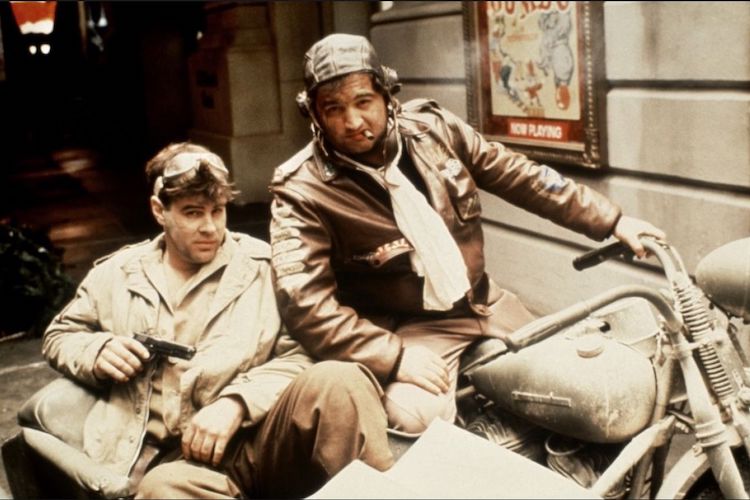The end of the 1970s saw some of the American filmmakers who had risen to prominence during the decade come under fire due to their hubris. The enormous price tag and years of bad press for Francis Ford Coppola’s Apocalypse Now (1979) set that director back. Martin Scorsese’s New York, New York (1977), a full-blown throwback Old Hollywood musical set in post-World War II, was a critical as well as a box office bomb.
It’s possible that its failure gave Steven Spielberg pause when he took over a project that had been developed by writers John Milius, Robert Zemeckis and Bob Gale, based very loosely on the real-life paranoid wartime hysteria that took over Southern California in the early months of 1942. The movie, eventually titled 1941 (released 40 years ago this month), did okay financially, but received a critical drubbing as well as a cultural shunning for the first decade or so after its release. Perhaps it would’ve fared better had Spielberg accomplished his original goal of making 1941 into a musical, thus fulfilling a lifelong desire of his. The concept was abandoned, but one standout sequence in the film—along with the general tone of the movie overall—allows it to qualify as the director’s first musical.
1941 was taken to task for its then-enormous price tag of $35 million (a mere $122 million in 2019 dollars), going over budget and over schedule, and the excess that’s reflected in the final film could’ve been even larger had Spielberg gotten his initial wishes. When the film was being developed in the summer of 1978, the director spoke with composer John Williams in the hopes of figuring out a plan to do eight musical numbers for the film. The songs would be in the style of big band music, the era-appropriate jazz offshoot that writers Zemeckis and Gale had specified in their script. One of the potential scenes discussed was a dance number at the “Hollywoodland” sign, and that would’ve been in addition to the movie’s large ensemble of characters as well as its elaborate and destructive setpieces. Ultimately, though, the reason for scrapping it was much simpler—as Spielberg says in Laurent Bouzereau’s documentary The Making of 1941 (1996), “I didn’t have the courage at that time in my life to tackle a musical.”
Nevertheless, a vestige of that concept made it all the way through to a sequence in the movie, the dance/chase/fight scene set in the USO-run Crystal Ballroom. In the scene, a non-enlisted troublemaker with a heart of gold, Wally (Bobby Di Cicco), has spent months practicing his dance steps with his sweetheart, good girl Betty (Dianne Kay), for the Ballroom’s Jitterbug contest, only to find that the contest is happening the same night the club has been taken over by the USO, of which Betty is a new member. Wally “borrows” a serviceman’s uniform to sneak in, and dances with Betty in the contest while attempting to avoid Cpl. Chuck “Stretch” Sitarski (Treat Williams), who hates Wally and is in lascivious pursuit of Betty.
The scene is a master stroke of choreography in every sense of that word, as a group of dancers synchronizes their steps on the floor while Wally, Betty, and Stretch alternate between dancing and avoiding each other. Most of the physical choreography was done by Paul De Rolf, while director of photography William A. Fraker uses the Louma crane to glide the camera seamlessly over the huge dancehall crowd. The entire thing is orchestrated by Williams to a thinly veiled parody of Benny Goodman’s big band hit “Sing, Sing, Sing”—in fact, the scene was rehearsed and shot to the actual tune, but after changes made in editing threw the timing off, Williams wrote his version (entitled “Swing, Swing, Swing”) to match the picture. It’s a sequence that’s so bravura, it could easily be the climax of any other movie. In 1941, it’s barely the midpoint.
While that sequence would be the highlight of the film and the only official musical scene in a Spielberg picture until the “Anything Goes” opening of Indiana Jones and the Temple of Doom, the entirety of 1941 can be seen as something of an unofficial musical. As Spielberg explained, “One of the things that confused myself as a filmmaker in my approach … is, in the back of my mind, I always saw 1941 as an old-fashioned Hollywood musical.” Prior to 1941, Spielberg’s films had had a distinct and unique relationship with sound design, taking the overlapping dialogue made famous by directors like Robert Altman in the early ‘70s and expanding it to realistic cacophony, with sound effects and dialogue enveloping each other in a messy fashion. 1941 is the epitome of this, where everything from the sound to the visuals are packed in so tightly that there’s a hundred things happening at once, seemingly out of control but meticulously planned out.
Had Spielberg taken out Williams’ score and put in a bunch of needle drops, the movie could’ve been a proto-Baby Driver, as it has a relentless sense of tempo (particularly in the Extended Version—the theatrical cut of the film is a bit of a rush job that muddles the characters and pace). The entire movie is structured as a giant Rube Goldberg machine (even putting in a scene where such a machine is explicitly detailed), a device that requires construction not unlike music, dependent as it is on expert timing. The Spielberg of 2019 is less arrogant and excessive than his 1979 self, but is still pursuing his dream of making a musical, having just completed his version of Bernstein and Sondheim’s West Side Story for 2020. If the man could make an almost-musical out of pratfalls and explosions, who knows what he’ll be able to do with actual songs.

